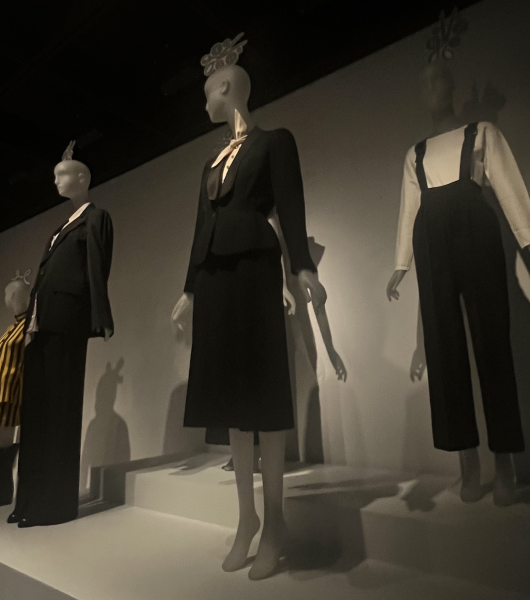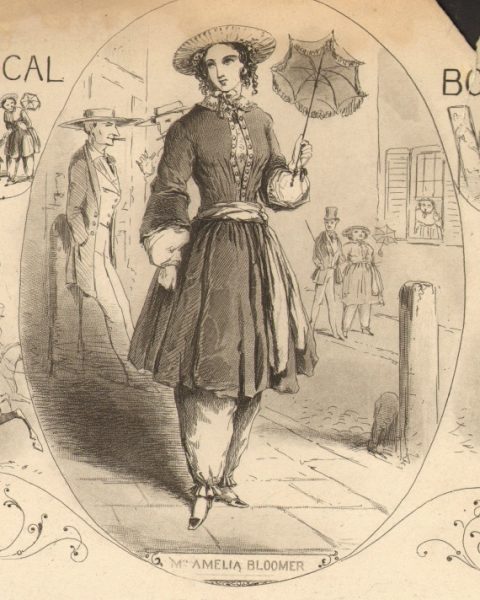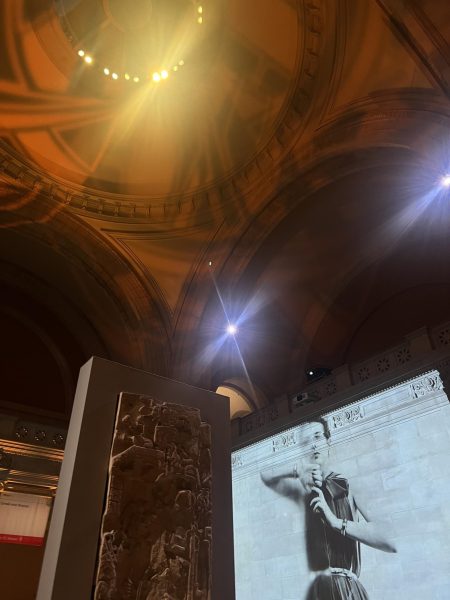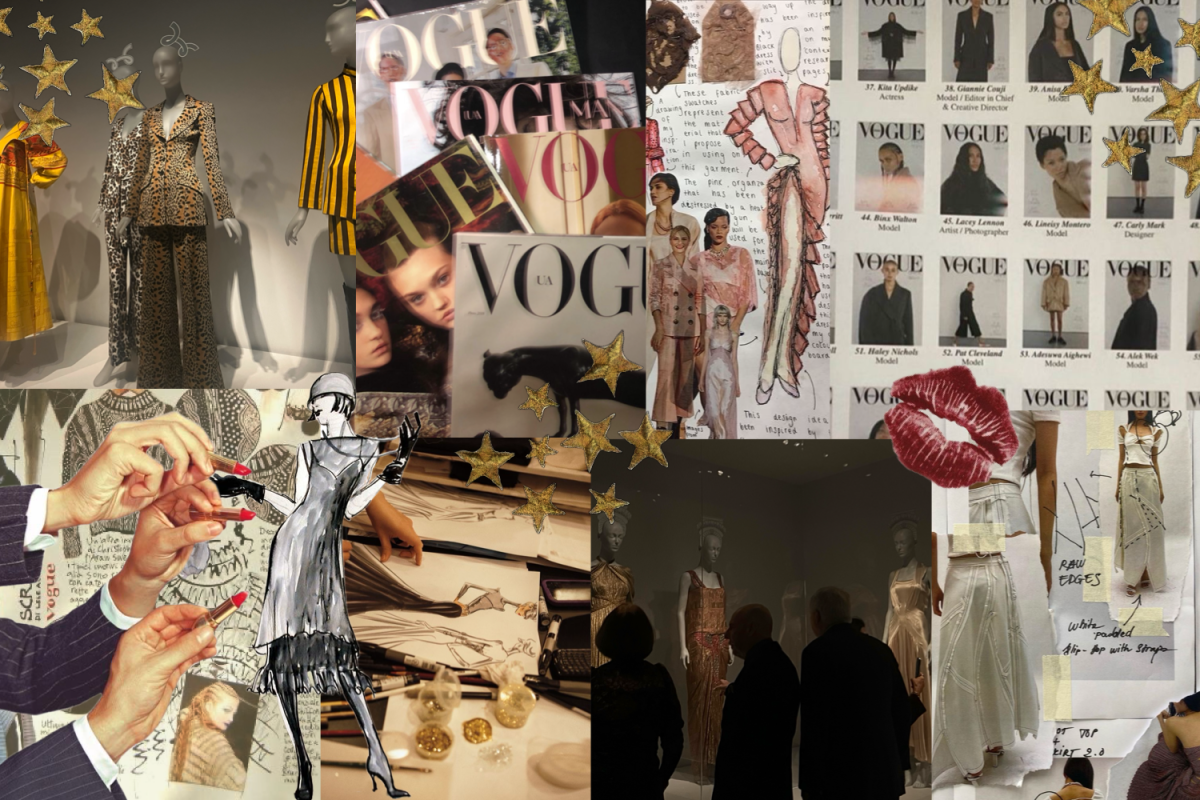The patting of stilettos and live jazz music soar toward the vaulting ceilings of the Metropolitan Museum of Art (The Met) as fashion lovers pour into the museum’s entrance. Historical artifacts such as the Maya Stone Monument and the Colossal Statue of Pharaoh accompany guests waiting for The Costume Institute’s Women Dressing Women exhibition doors to open. While the production traces the progression of Western fashion throughout history, the permanent collection also displays how fashion works as an outlet for self-expression and empowerment for women.

The Met’s new exhibition, Women Dressing Women, spotlights the legacy of female fashion designers and the role of their work in feminist history, featuring work from 1910 to today. The exhibition opened to the public December 4, 2023, serving as the first exhibit the Met has dedicated solely to the work of women, according to The New York Times.
As I made my way around The Met’s newest fashion maze, I noticed that the attendees of the Women Dressing Women exhibition were mostly female. As men mostly run leading brands today, it was truly reinvigorating to appreciate fashion through a feminist lens. The “Appropriating Menswear” section of the exhibit, with its unique designs and silhouettes, particularly caught my attention. This section featured works of American designer Ms. Elizabeth Hawes, Franco-American designer Ms. Pauline Trigère, German designer Ms. Jil Sander, Belgian designer Mrs. Ann Demeulemeester, and more.
Designer Ms. Elizabeth Hawes distinctly stood out to me due to her history in feminism and activism. Decades ahead of her time, Ms. Hawes questioned clothing’s gender binary as her designs subverted the public’s expectations of male and female sartorial choices, according to fitnyc.edu. Through her unique designs, the female designer criticized the exploitative, classist nature of the fashion industry. Indeed, Ms. Hawes tirelessly challenged contemporaneous gender norms with her clothing as she advocated for men to wear skirts and conversely encouraged women to wear trousers, according to fitnyc.edu.

Throughout history, fashion has been one of the few outlets of empowerment and creative expression for women. Prior to the 1800s, women wore restrictive corsets with heavy and tight structures. However, seeking to change women’s fashion, feminist Mrs. Amelia Bloomer invented the first female trousers, according to lofficielusa.com. Early feminists adopted the new garment as it embodied independence in their lives and closets. While the trousers became a symbol of the feminist movement, women faced controversy. Such debates led to women trading their trousers back in for traditional female dress.
However, during the 1900s, women began to join the workforce as secretaries and began to participate in sports, making the traditional, uncomfortable dresses no longer feasible for women, according to lofficielusa.com. Although women wore matching suits as sportswear, the suits trickled into the movement, becoming a symbol of feminism. Female fashion designer Ms. Coco Chanel helped introduce this sportier female look during the time, which became more popular during World War II when women entered the workforce, according to glamourmagazine.co.uk.
Such a shift in female wardrobe extended into the 1970s and 1980s, as more women joined the workforce. With women working in offices and firms, business attire became intersex instead of exclusively for men. The new style gave women a more masculine and professional look made up of matching skirts and jackets with padded shoulders, according to pbs.org. Challenges accompanied the liberation of feminine dress as the divide between feminine and masculine dressing became more prominent. However, such liberations were reflective of women’s new identity as they moved beyond domestic roles.
Since then, women have persisted in experimenting with ways to reclaim the body as a site of creative expression and disrupt conventional standards of beauty. Female designers today examine ways to continuously consider the broader impact that sartorial choices may have on future generations in a globalized society, according to glamourmagazine.co.uk.

Contrary to popular belief, mostly men lead brands in the fashion world. In fact, a study by the Council of Fashion Designers of America revealed that women run fewer than 50 percent of womenswear brands, and women lead only 14 percent of major fashion brands, according to mckinsey.com. Thus, Women Dressing Women invites individuals to admire the work of female designers, instilling a sense of appreciation for female-owned brands and lesser-known designers. Through sartorial choices, individuals communicate their identity and creativity. It is vital to recognize the designers who subverted conventional norms and provided women with a platform to express themselves throughout history.
Truly, women are instrumental in shaping the creative vision of fashion through their role as designers due to their understanding of the female body and lifestyle. Men often design articles of clothing that appeal to the male gaze, rejecting the sense of comfort a woman may desire in their clothes. In fact, a man designed the first corset, valuing the aesthetic of the female body, while ignoring the discomfort that accompanied the look. Frankly, while one’s sense of style is subjective, comfort is objective.
The fashion industry provides a platform for women to express themselves and challenge societal norms. While the Women Dressing Women exhibit spotlights 80 female-made articles of clothing, the works of many female designers remain under-appreciated due to the domination of men in the fashion field. Ultimately, women must reclaim their ability to design their own clothing by subverting the male perception of beauty in fashion.
Featured Image by Ana Patricio ’24




